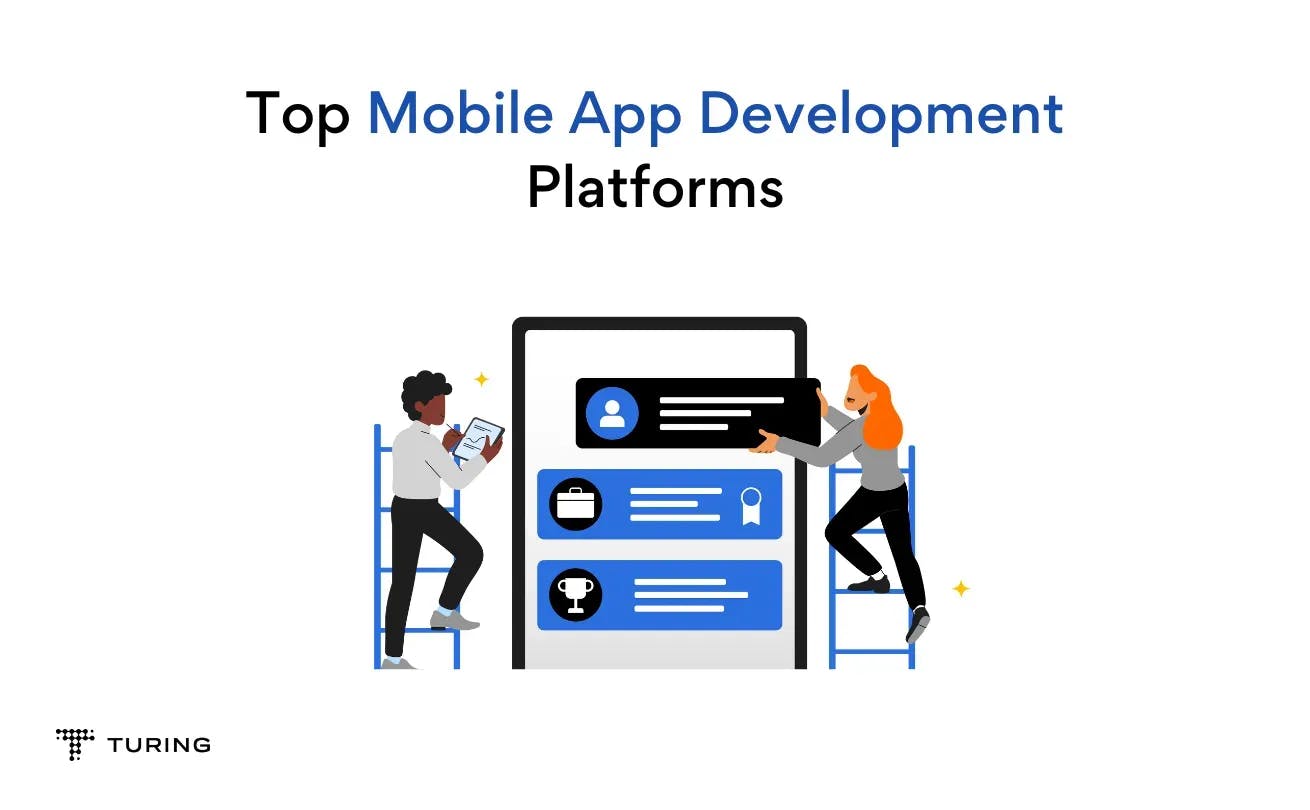7 Best Mobile App Development Platforms

Turing Staff
•8 min read
- Application and cloud

Mobile apps have become an integral part of our daily lives, providing us with a wide range of services and information at our fingertips. From social media and entertainment to banking and shopping, there's an app for almost everything we need. An increasing number of people are turning to their smartphones and tablets to access the internet and interact with brands and businesses.
By creating a mobile app, you can tap into this vast and growing market, reaching new customers and providing them with a convenient and engaging way to interact with your brand. In addition to the increased reach and customer engagement, mobile apps can offer a range of benefits for businesses, including improved productivity and efficiency, customer loyalty and retention, and the ability to gather valuable data and insights from user behavior.
So if you're considering developing a mobile app, check out our list of the 7 best mobile app development platforms. With the right tool and creativity, you can turn your app idea into a reality and tap into the vast potential of the mobile market. But before hopping onto our main agenda, let’s briefly discuss mobile app development platforms and their benefits.
Let’s get started.
What are mobile app development platforms?
Mobile app development platforms are software programs that provide tools and resources for building mobile applications for various operating systems, such as iOS, Android, and Windows. These platforms typically offer a range of features and services to help developers create, test, and deploy mobile apps more efficiently and effectively.
Mobile app development platforms are generally of 2 types:
- Native app development platforms: These platforms are designed to build apps for a specific mobile operating system, such as iOS or Android. Native app development platforms provide access to native APIs and tools for creating apps that are optimized for performance and user experience.
- Cross-platform app development platforms: These platforms allow developers to create apps that can run on multiple mobile operating systems using a single codebase. This can be a more efficient and cost-effective option for companies that want to reach a wider audience without creating separate versions of their app for each platform.
Benefits of mobile app development platforms

Some specific benefits of mobile app development platforms include:
- Ease of use: Mobile app development platforms often provide a user-friendly interface and a set of pre-built components and features that can help simplify the development process. This can be especially useful for companies new to mobile app development.
- Cross-platform compatibility: Some mobile app development platforms allow developers to create apps that can run on multiple mobile operating systems using a single codebase.
- Integration with cloud-based services: Many mobile app development platforms provide integration with cloud-based services and tools. This can help simplify the development process and reduce the need for developers to build and maintain their own servers and infrastructure.
- Testing and debugging tools: Mobile app development platforms often provide a range of tools and services for testing and debugging apps, including simulators and emulators, as well as tools for tracking and fixing issues. This can help developers ensure that their apps are high quality and perform well on different devices and operating systems.
Top 7 mobile app development platforms
Xamarin
Xamarin is a popular app development platform for building iOS, Android, and Windows apps using C# and .NET. It offers a range of tools and services for creating, testing, and deploying mobile apps, including a visual designer, debugging tools, and integration with cloud-based services such as Azure.
One of the key benefits of Xamarin is that it allows developers to reuse code across multiple platforms, saving time and resources. However, it may require a more advanced level of programming knowledge, as it uses C# and .NET.
Features:
- Code reusability: Facilitates developers to share up to 90% of their code across different platforms.
- Full native apps: Xamarin aids in the development of fully native Android, iOS, and Windows apps using a single .NET codebase.
- Native API accesses: Ensures efficient, effective apps with a truly native look and feel.
Flutter
Flutter is an open-source mobile app development platform created by Google. It allows developers to build apps for Android, iOS, and the web using a single codebase and offers a range of features and tools for building visually appealing and responsive apps. One of the best features of Flutter is its Hot Reload feature, which allows developers to make changes to their code and see the results in real time, saving time and effort.
Flutter also provides a range of tools and services for building the backend of an app, including integration with cloud-based services and tools for user authentication, data storage, and push notifications. However, one limitation of Flutter is that it may not be as well-suited for building apps with complex graphics and animations as some other platforms.
Features:
- Hot reload: This allows developers to experiment, build UIs, and rectify bugs faster.
- Customizable widget sets: It provides ample toolsets for rapid and effective UI coding.
- Single codebase: It runs on multiple platforms, offering synchronized updates.
Cordova
Cordova is a popular open-source mobile app development platform that allows developers to create cross-platform apps using HTML, CSS, and JavaScript. It provides a set of plugins and APIs for accessing native device features and functionality, such as the camera, GPS, and storage.
Cordova also offers integration with a range of tools and services for building and deploying apps, including support for continuous integration and delivery. However, one limitation of Cordova is that it may not provide as smooth a user experience as some other platforms, as the app may not be as well-optimized for each operating system.
Features:
- Universal operating systems: This technology allows the same app to run on different mobile operating systems.
- Plugin library: Declared access to native device features is an advantageous attribute.
- Uses familiar technologies: Coders can create apps using CSS3, HTML5, and JavaScript.
Sencha
Sencha is a mobile app development platform that provides a set of tools and services for building cross-platform apps using HTML5 and JavaScript. It offers a range of features for building visually appealing and responsive apps, including support for various UI components and layouts.
Features:
- Visual data representation: With a variety of charts for diverse data perspectives, Sencha is a clear winner.
- Extensive UI components: A massive set of pre-tested and integrated UI components accelerates time-to-market.
- Front-end developer friendly: Being based on JavaScript, it's a favorite tool for front-end developers.
Unity
Unity is a popular platform for building cross-platform mobile apps, games, and interactive content. It provides a set of tools and services for creating, testing, and deploying apps, as well as integration with a range of services and tools for building the backend of an app.
One of the best features of Unity is its support for a wide range of OS, including iOS, Android, and Windows. However, one limitation of Unity is that it is a performance-intensive platform, and apps or games built using Unity might not function at optimum levels on legacy or older devices.
Features:
- Advanced rendering: Assures a rich, engaging visual experience.
- Collaboration: A collaborative toolkit for teams enhances productivity.
- Analytics: Real-time insights with live-ops analytics aid in understanding user behavior and engagement levels.
Ionic
Ionic is an open-source mobile app development platform that allows developers to build cross-platform apps using HTML, CSS, and JavaScript. It provides a set of tools and services for building visually appealing and responsive apps, as well as integration with a range of cloud-based services and tools for building the backend of an app.
Ionic’s USP is its simplicity and accessibility, as it uses web technologies that many developers are already familiar with. However, it may not offer the same performance and native feel as a native app development platform. Also debugging your code with Ionic can often become complicated because of vague error messages.
Features:
- Single codebase: Performs seamlessly on any platform or device.
- UI interface: A rich set of UI features and gestures to offer rich user experiences.
- Web technologies-based: It utilizes standard web technologies such as HTML, CSS, and JavaScript.
React Native
React Native is a popular mobile app development platform created by Meta. It allows developers to build native apps for iOS and Android using JavaScript and the React library and offers a range of tools and services for building, testing, and deploying apps.
One of the best features of React Native is its ability to create a smooth and seamless user experience, as the app is built using native components and APIs. React Native also provides a range of tools and services for constructing the backend of an app.
Features:
- Like native apps: The ability to build mobile apps in JavaScript that can perform like any native app.
- Hot reloading: This feature enables faster development and deployment.
- Flexibility: Easy integration with third-party plugins and compatibility with other platforms such as tvOS.
NativeScript
NativeScript is a prominent open-source framework used for the development of mobile apps on Android as well as iOS platforms. With NativeScript, you can create native apps for Android and iOS using a single codebase. With NativeScript, developers can build mobile apps in Typescript, Angular, or JavaScript.
Features:
- Truly native: The framework enables developers to create fully native mobile applications using web technologies.
- Single codebase: Like many other mentioned platforms, NativeScript lets developers build mobile applications for iOS and Android using a single codebase.
- Language flexibility: Offers the flexibility to write and deploy mobile apps in JavaScript, Angular, or TypeScript.
- Direct access to native APIs: NativeScript allows direct access to every native platform API using JavaScript, TypeScript, or Angular.
- Extensive plugin library: A rich ecosystem of plugins to speed up the development process.
Final thoughts
In conclusion, when choosing a mobile app development platform, it's essential to consider factors such as the type of app you want to create, the operating systems you wish to support, and the available resources and tools. Each of the above platforms has its own strengths and weaknesses; the best choice will depend on your specific needs and goals.
Ultimately, the most critical factor in the success of a mobile app is its quality and usefulness to users. By choosing the right development platform and utilizing the available tools and resources, developers can create apps that meet the needs of their users and drive engagement and retention.
Want to accelerate your business with AI?
Talk to one of our solutions architects and get a complimentary GenAI advisory session.
Get Started
Author
Turing Staff
